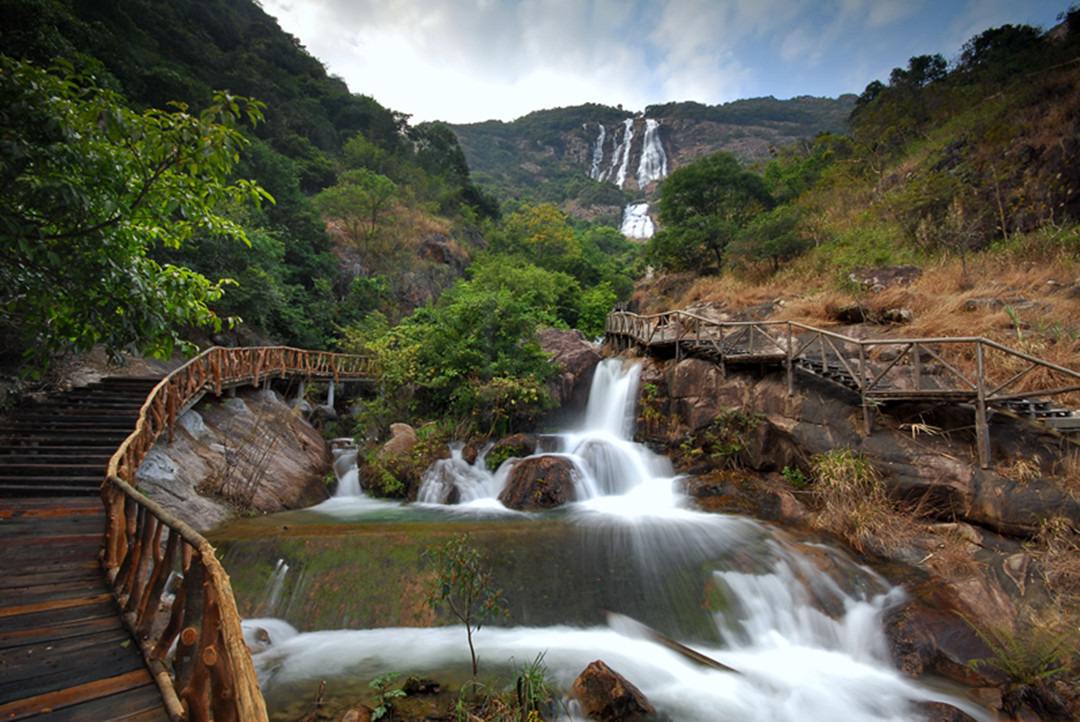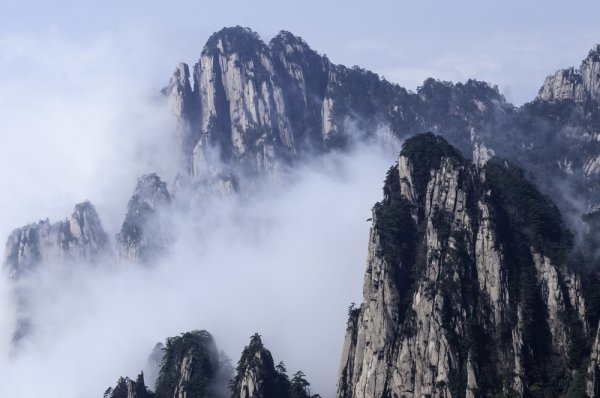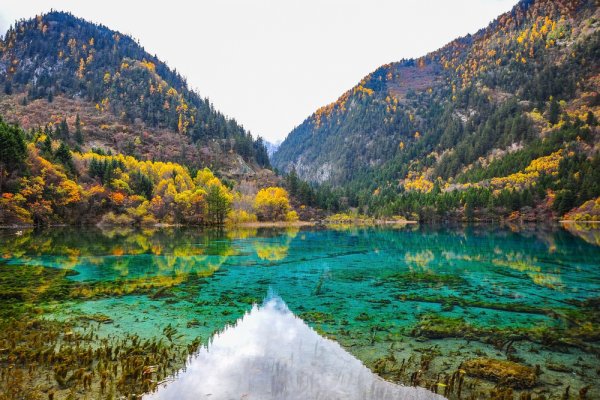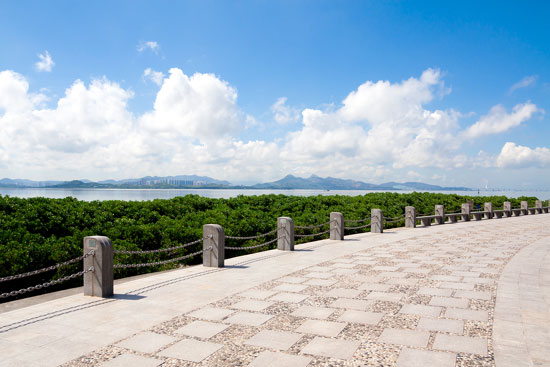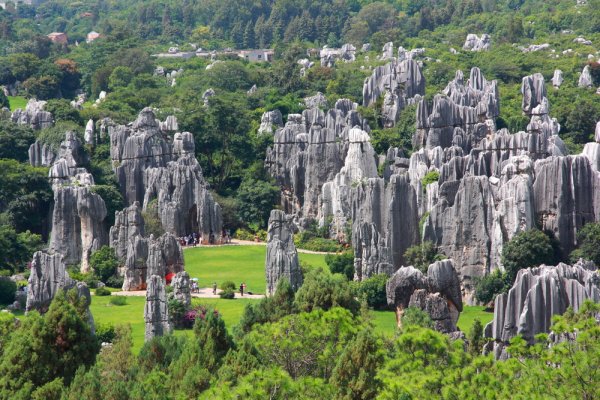Points of Interest
Baishui Fairy Waterfall
Paitan Town, Zengcheng District
Guangzhou, China
Mainland China’s tallest waterfall is in Guangzhou’s Whitewater Village Scenic Area. Baishui Fairy Waterfall is a series of three cascades that stands 428.5 meters (1,406 feet) tall on the Baishui River. A 6.6-kilometer (4.1-mile) path with 9,999 stairs leads to the top of the waterfall or an alternative route is a boardwalk called the Plank Road. The lush mountainous area has been referred to as a magnificent jade on the Tropic of Cancer, due to its latitudinal location.
Dameisha and Xiaomeisha Beaches
Yantian District
Shenzhen, China
It can be tough to find a pleasant beach in China, but these two beaches, which are the most popular in the Shenzhen area, both provide a relaxing seaside atmosphere with lapping waves and golden sands. With names meaning "large beautiful beach" and "small beautiful beach" respectively, Dameisha and Xiaomeisha are adjacent to one another along the southern coast of the South China Sea, a few kilometers east of central Shenzhen. The larger of the two, Dameisha, is a public beach with free entry and is, consequently, usually the busier of the two. Xiaomeisha, meanwhile, sits on the cove just east of Dameisha and is a private beach requiring a ¥20 entrance fee. Besides this fare and their sizes, there is very little difference between the two beaches, both of which have a series of small stands offering water toys and snacks.
Huangshan Mountains
Anhui, China
Originally known as Mount Yishan, the mountain range got its present name, Huangshan Mountains, in 747 BCE during the reign of Emperor Tianbao. The mountain range is made up of numerous peaks, 77 of which exceed an altitude of 1,000 meters (3,281 feet). The popularity of the area stems from its beauty, mostly in the form of granite peaks, pine trees, hot springs, and natural pools. The tall mountains also offer a number of interesting phenomena and light-effects, notably the "Sea of Clouds" and "Buddha's Light." This UNESCO World Heritage Site is home to a wide range of diverse flora and wildlife, and Mao Feng, a very popular green tea.
Jiuzhaigou National Park
Nine-Village Gully National Park Nanping County
Sichuan, China
Jiuzhaigou (Nine-Village Gully) National Park, located in the mountains of Nanping County, covers an area of 72,000 square kilometers (27,799 square miles). Jiuzhaigou Valley measures more than 4,800 meters (15,748 feet) in height and comprises a series of varied forest ecosystems. The park mainly consists of three major gullies, spectacular waterfalls, alpine lakes, diverse vegetation that includes rare flowers and grasses, various endangered species of wildlife, and rare birds. Famous sites in the park include the Lying Dragon Lake, the massive Magic Mirror Cliff, Nuorilang waterfalls, Pearl Shoal, and Long Lake, the largest lake in the valley.
Lushan National Park
Jiangxi, China
Lushan National Park, a popular tourist location, is famous for its beautiful scenery and cultural heritage. Stretching for about 829 square kilometers (320 square miles), it contains more than 90 mountain peaks, the tallest of which is the 1,474-meter-tall (4,836-foot-tall) Hanyang Peak. The major attractions of the park include beautiful natural attractions like rivulets, rocks, waterfalls, grottoes, ravines, steles, and cliff inscriptions. Some of the park's most popular attractions are Ruqin Lake, Xianren Dong, Sandie Spring, Wulao Feng (a mountain range), Lulin Lake, Flower Path, Dolphin Temple, and Jinxiu Valley.
Red Forest Mangrove National Park
Binhai Road
Futian District
Shenzhen, China
Situated just a couple of miles north of Hong Kong's famed Mai Po Marshes-legendary for birdwatching-is China's smallest national park. Named for the red-tinted trunks of the mangrove trees that grow in the wetlands around the park, Red Forest Mangrove National Park was nearly destroyed by the construction of a freeway in the 1990s. Though small, the park is an important resting stop for migratory birds along the East and Australasian Flyway. Each year, around 180 different types of birds pour into the park, at least 20 of which are considered rare or protected species. Even for those not interested in birding, Mangrove National Park makes for a very pleasant visit, with meandering sidewalks that follow the seashore and provide excellent views.
White Cloud Mountain
Xin Village
Guangzhou, China
Locals regard White Cloud Mountain, also called Baiyun Mountain, as one of the finest scenic areas in Guangdong. Scholars and poets have found it an inspirational place of beauty for centuries. Today, the Baiyun Shan area, which spreads across the north side of Guangzhou, offers locals and visitors alike an ideal place to escape from the smog of the city. The Baiyun Shan encompasses six sightseeing regions, including the range's highest peak, Moxing Ridge, as well as a number of valleys, lakes, and forests. A cable car circulates between Yuntai Garden and Peak Park. Campsites and hiking trails abound.
Yunnan Stone Forest
Shilin Yi Autonomous County
Yunnan, China
One of the most important tourist attractions in Yunnan Province, the Yunnan Stone Forest occupies an area of 38,850 hectares (96,000 acres). The forest includes both big and small stone forests, and numerous other scenic spots. The forest gets its name from the many beautiful stone formations and shapes that can be found here, all of them naturally formed. The formations take the shapes of animals, plants, and even human figures, and each possesses its own unique characteristics. Some of the popular places in the park are the Subterranean Stone Forest, Strange Wind Cave, Long Lake, Naigu Stone Forest, Major Stone Forest, and Minor Stone Forest. The native Sani tribe uses the forest as the venue for their annual national festival, the Torch Festival.
Zhoukoudian
Fangshan District
Beijing, China
Zhoukoudian is famous as the cave residence of Peking Man, who is believed to have lived here 200,000 to 500,000 years ago. With the discovery of a whole skull in 1929, Zhoukoudian became world renowned as the home of the Chinese ape-man, thereby attracting huge numbers of tourists and scientists. The actual site of the caves occupied by Peking Man is on the northern part of Dragon Bone Hill. The hill now has a seven-room exhibition hall dedicated to the Peking Man. One of the caves measures about 43 meters (140 feet) across and 40 m (131 ft) high. Scientists estimate that it was occupied for more than a quarter of a million years.
Copyright © 1993—2025 World Trade Press. All rights reserved.

 China
China 